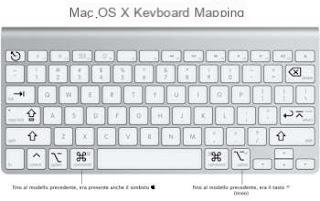 Whatever operating system or program you are using, knowing and knowing how to use key combinations makes everything easier and every job faster.
Whatever operating system or program you are using, knowing and knowing how to use key combinations makes everything easier and every job faster.The fact of not having to take your hands off the keyboard while typing something or being able to browse the internet by opening multiple sites together and moving from one to the other without using the mouse saves a lot of time.
We talked about keyboard shortcuts on Windows PCs and now let's see one MAC keyboard guide, which is very similar, although there are some keys with different names.
The main of them is the CMD button or Command, which is the key to using so many key combinations and which can be thought of as the CTRL key on a Windows PC.
In addition to CMD, the other important keys on a Mac whose purpose and use must be known:
- OPT or Option key which is the equivalent of the Windows Alt key, indicated with a slash symbol from left to right.
- Control, which is also indicated by a caret symbol ^ or CTRL, is mostly used in conjunction with a mouse click to open the context menu.
- Fn (Function), to use the Function keys F1, F2 etc. in the handsets.
- Shift or Shift, also indicated with an up arrow.
- Caps Lock, the caps lock, to write uppercase when turned on, also indicated with an up arrow and a line below.
- Delete, indicated with a left arrow which is like the PC CANC key.
- Esc, to exit the programs.
- Eject, the top right key with an up arrow.
Speaking of key combinations, on Mac, there are so many that it is also difficult to remember them all.
Source most important however they can be summarized as follows:
Key combinations that can be used during Start / Stop
Press the C key at power up to start the Mac from a bootable disk.
- CMD-S, Boot into single user mode.
- SHIFT, Boot into Safe Mode.
- OPT-CMD-EXPELL, to put computer in sleep mode.
- CTRL-Eject, to open the Reboot, Sleep, Shutdown options window.
Key combinations on Finder and app icons
- CMD-A - Select all.
- CMD-C - Copy.
- CMD-X - Cut.
- CMD-Z - Undo / Redo.
- CMD-V - Paste.
- CMD-S - Save.
- CMD-O - Opens the selected file (as in Windows by pressing the Enter key which on Mac opens the file rename).
- CMD-F - Open Find.
- CMD-N - New Finder window.
- CMD-Shift-N - Create new folder.
- CMD-R - View original of an alias.
- CMD-W - Close window (like Alt-F4 on Windows)
- CMD-M - Minimize window.
- CMD-Q - Exit an application.
- CMD-OPT-ESC - Options for force quit (basically like the Windows task manager that opens with CTRL-Alt-Del on Windows)
- CMD-arrow keys to go to the beginning or end in a line, like the Home and End keys do in Windows.
Keyboard combinations for screenshots
- CMD-SHIFT-3 - Screenshot of Full Screen.
- CMD-SHIFT-4 - Capture only selected area.
Combinations for Spotlight and Applications
- CMD-Space - Open Spotlight.
- CMD-Tab - Switch to another application used.
Keyboard combinations within programs
In any Mac OS X program, you can find useful keyboard shortcuts just by looking at its menu items.
Next to each menu item, usually, there is indicated the combination to use to do that operation.
You can too create custom key combinations in System Preferences, in the Keyboards section.
From here, you can add key shortcuts to control all sorts of actions on the Mac.
For example, those coming from a Windows PC can here swap the CMD key with CTRL.
To learn how to write special characters, symbols and emojis on Mac, you can read this guide from the Apple website.
Also on the Apple website you can have an overview of all the keyboard shortcuts possible on Mac.
MAC keyboard guide and key combinations


























